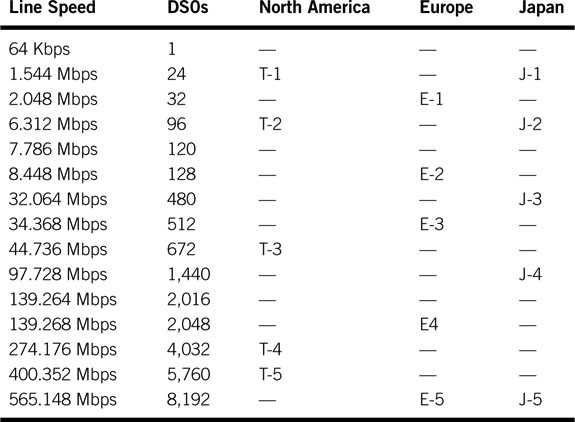Appendix F: Digital Hierarchies
Two main classes of telecom-based digital links are in worldwide use for transporting telephone and data signals. One system is called plesiochronous digital hierarchy (PDH) and is based on multiplexing numerous individual channels into higher rate channels. The PDH is not synchronous but “nearly synchronous.” The second link type depends on synchronous communications. The United States and Canada rely on SONET, whereas the rest of the world uses SDH. SONET stands for Synchronous Optical NETwork, and SDH is an acronym for Synchronous Digital Hierarchy. The ITU adopted SONET, with small variations, as the basis for the SDH. The SONET/SDH standards define a hierarchy of interface rates that permit different line rates to be multiplexed as with the PDH method.
The PDH uses clocks of different accuracies, whereas SONET transmits using a highly stable reference-clocking source for the entire SONET network. Both use different framing methods, line rates, line coding, and timing. Despite the many differences, there are common features to both systems:
• Each has a defined hierarchy of data rates (see later) for multiplexing lower rate signals of the same type.
• Each can carry telephone data payloads in multiples of DS0 (digital signal 0) at 64,000 bits per second.
• Many telecom carriers offer PDH (T1, T3) and SONET/SDH (OC-3, OC-12) links as WAN access connectivity to their network.
• Various data packaging methods are defined: IP packets over either, ATM over SONET/SDH, MPEG TS over either, and others.
The underlying technology of the PDH and SDH is complex and is not covered here. Table F.1 outlines the common naming and hierarchical relationships of the two methods.
Table F.1 PDH Naming and Rate Relationships

North America, Europe, and Japan have chosen different basic PDH line rates, but the other aspects are identical. The J terminology is a colloquial naming scheme for Japan, and E is for Europe and T for North America. The physical links are copper based for T1/T3 and E1/E3 but are usually optical for higher rates. Rates beyond T3/E3/J3 are not in common use for WANs.
F.0 OPTICAL CARRIERS IN SONET AND THE SDH
In SONET and the SDH the optical standard is typically known by an OC-x number, where x is a multiple of the OC-1 rate of 51.84 Mbps. While the optical system is common, there are small differences in framing and bit rates between SDH and SONET. North America uses a STS-x (synchronous transport signal) format for frames (packets), whereas Europe uses a STM-x (synchronous transport module) format. Table F.2 lists the various SONET/SDH relationships.
Table F.2 SONET and SDH Relationships

F.1 CONCLUSION
The PDH and SONET/SDH systems are the backbone of the telecom industry. Many telecom carriers offer A/V-friendly WAN services over T3/E3 and higher rates. IP data packaged over either method is a common offering. These methods plus pure Ethernet connectivity will continue to be the foundation of WAN technology worldwide.
